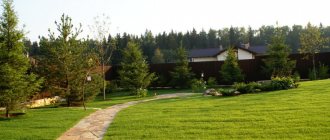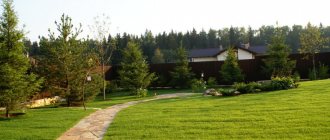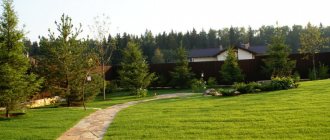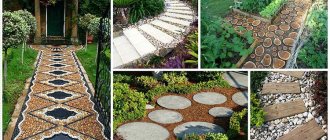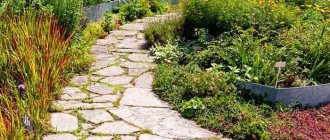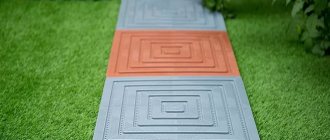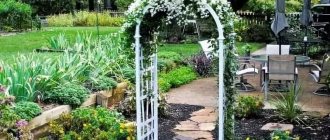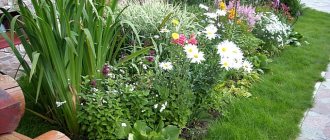Paths in the garden, in addition to their practical functions, harmoniously complement the landscape design of the garden plot. Laying out walking routes through country estates is, of course, a serious matter, but the picture would remain unfinished without the final, but extremely important, touches. Today we bring to your attention three landscape-style sketches that you can use to design paths in your own garden. For each option, we will show you a planting scheme, their photos and names by height, flower color and flowering period.
Gravel path
This is a budget option for designing a country path. Thanks to its structure, gravel will perfectly allow water to pass through empty areas, which will allow you to walk comfortably in rain and mud.
This material will help you easily give the desired shape for the garden path, which can always be changed or supplemented. This is a simple, effective and mobile option for landscaping.
One of the disadvantages is that gravel perfectly allows weeds and grass to pass through. And it will have to be cleaned periodically. Like any number of small elements, gravel is difficult to keep in one position. And to maintain the integrity of the design, it is better to use borders for garden paths.
Weigela blooming
Weigels usually bloom twice a year. This original shrub is showered with red, cream, pink and white bells during flowering. Weigela prefers brightly lit places or light partial shade. The delicate petals of the plant can easily be damaged by the wind, so you need to choose protected areas for the bushes.
The culture prefers fertile and loose soil. It is better to make a substrate of humus, sand and turf and add rotted leaves to them. Drainage is placed at the bottom of the planting hole - coarse sand or gravel.
Nana purpurea is one of the most popular weigela varieties. This is a compact bush no more than 1 meter high. It has oval leaves with sharp tips that change color from brown to green. Shrubs are very decorative and are constantly used in landscape design.
Using lawn to create a path
What are the nuances when making garden paths from lawn? To maintain an attractive appearance, the lawn requires constant care. Watering, weeding and cutting.
It is also important to have constant natural light. With constant use, it quickly gets trampled, bald spots appear and the overall appearance deteriorates.
One of the advantages is that with proper care, the path looks very beautiful and creates a feeling of comfort and well-groomed. In addition, it is pleasant to walk on it.
There is an interesting life hack for caring for such a path. To make lawn maintenance easier, choose a width that matches the width of your lawn mower. This will save time significantly.
Decorating a flower bed in front of the house
You can make an ideal front garden with your own hands in front of your house, provided you can understand what types of flower beds there are. There are:
- Open flowerbed . It consists of a lawn on which paved paths and flower beds are concentrated. You should not plant a lot of trees and shrubs. This creates the visibility of wasps on all sides.
- Closed flowerbed . It got its name due to the fact that there is a fence. It can be in the form of a hedge or a small architectural form. But you can see what garden balsam looks like in a flowerbed in the photo in this article.
Here's a video of what a decorated flower bed in front of the house will look like:
It is necessary to choose the type of flower garden in front of the house taking into account your own wishes. If you love silence, privacy and tranquility, then you should choose a closed type of flower bed. But for those who are not afraid of prying eyes, you can plant flowers in an open flowerbed.
Tile path
Paving slabs add a sense of elegance to the space. The main feature is the minimum requirements for care and maintenance. With high-quality installation, tiles will serve you for many decades. And keep a well-groomed appearance.
But there are also disadvantages to this style. First of all is the price. This type of design is considered the most expensive. Even DIY installation will not help reduce costs.
Some tips for laying paving slabs yourself:
- To add more rigor to the design, use a garden border.
- The tiles must be laid when it has not rained and will not rain for at least a week. This is the most important condition. It is its compliance that determines the service life of the track.
- If you live in an area with heavy and prolonged rain, you should consider drainage for the path.
Plant selection
Before fencing, it is better to plant plants with the following characteristics:
- do not require careful maintenance;
- decorative throughout the season;
- drought resistant;
- tolerant of soil salinity;
- little susceptible to disease, rarely attacked by pests.
It is recommended to plant plants with thorns and thorns, which effectively prevent them from being destroyed, torn off, trampled and eaten by animals.
The plants presented below are reliable and unpretentious:
- thorny shrubs (Thunberg barberry, Juliana, caragana tree, pyracantha, Japanese quince, rose hips);
- deciduous shrubs (cotoneaster, privet, bladderwort, cinquefoil, spirea, common hawthorn);
- unpretentious vines (ivy, virgin grapes, petiole hydrangea);
- coniferous plants (thuja, pine, juniper, yew);
- unpretentious flowers and herbs.
Photo. Hedge on a yew fence
river stone
The simplest river stone can turn a path into a work of art. By selecting a sufficient number of light, gray and dark stones of similar shade, you can lay out any picture or ornament. This is long and painstaking work. But the resulting design will be absolutely unique. And you can be proud of yourself, listen to rave reviews from friends and family.
First of all, it is necessary to sort the stones by color, and also get rid of defective stones and stones with obvious flaws. To facilitate further work, you can sort the stones by size.
It is important to create a feasible sketch of the future path. You can use ready-made ideas from the Internet or come up with your own design. It's easiest to style curls or squares.
Time to plant trees and shrubs along the fence and paths
In order for the plants to successfully survive the winter period, saturated with low temperatures and powerful winds, when planting, listen to the advice of experts and pay attention to the following points:
1. When planting trees and shrubs, step back from the fence to the distance required for the development of the plant. Otherwise, the roots may destroy the fence, and the crown may shade the neighboring area, causing displeasure to the neighbors. The generally accepted distance from the fence for a tree is 3 m, for a bush it is 1.5 m.
Table of distances between plantings
2. Move large trees at least 5 m away from the fence. They subsequently form a powerful crown and grow significantly higher than the fence.
3. When planting plants, you need to ensure that there are no places with stagnant air on the site. During winter frosts, seedlings in this area may freeze.
4. It is also necessary to retreat about seven meters from the residential building, otherwise the tree may destroy the foundation with its roots.
5. When planting, retreat significant distances from the water supply.
6. Keep trees and shrubs, especially those that produce edible fruits, away from the drainage pit.
The most appropriate time to plant trees and shrubs along the fence and paths is generally considered to be autumn. There is a rule that bushes and trees that bloom in spring are best planted in the ground in the fall. Vegetation takes root well in spring and blooms in late summer.
Shrub planting scheme
Based on these recommendations, it is better to postpone planting until the autumn. This must be done before frost, it is advisable that the plant has time to take root. Most often, plant transplantation is performed in October. If there is a need to do this later, but the frost has not yet set in, you can carry out the work, but provide additional insulation. To do this, add sawdust or peat near the trunk.
Mulching bushes along the fence with sawdust
During frosts, replanting trees and shrubs is not recommended. It is better to simply dig them in in an inclined position, cover the roots with a layer of peat and soil, and plant them in the spring.
Digging seedlings for the winter
When choosing trees and shrubs for planting along the fence and paths, take into account the recommendations given in the article. They will help you properly organize the green space of your suburban area. Receive aesthetic pleasure, relaxation and enjoyment from country life.
Path using tree bark
Bark is a cheap material that can be purchased at any hardware store. An interesting feature of the bark is that it prevents weeds from growing. Accordingly, such a path will require a minimum of care and time.
Flaws:
- it is necessary to add bark to the path every season;
- Some of the material is carried by the wind or on the soles of shoes, which also affects the need to add bark to some areas.
Recommended types
There are sixteen varieties of plants that can be planted along garden paths.
Sedum
This is a low-growing plant that grows up to fifteen centimeters in height. The advantage of sedum is its resistance to almost any climatic conditions. It can withstand severe droughts and cope with high humidity. This flower is easy to grow, as it does not require fertilizing or frequent soil moistening.
Scottish moss
Some summer residents do not want to plant tall plants in the garden near paths. In this case, you can plant the area with moss, which grows up to two centimeters in height. Gardeners recommend planting it in shaded areas with high humidity. Moss grows best in the eastern part of the garden plot. Scotch moss is easy to grow. However, it will have to be watered daily so that the soil does not become dry.
creeping thyme
This is wild thyme, which is popular among garden owners. A special feature of this plant is its purple color. Thyme blooms in the second half of spring or early summer. In this case, such grass does not grow upward, but spreads over the surface of the soil. The advantages of creeping thyme include its low cost and ease of cultivation.
Garden chamomile
You can decorate your garden path with daisies. This medicinal herb does not require special care and is easy to grow. However, despite this, it should be planted in a cool and dry place with moderate air humidity. Caring for garden chamomile is easy. It is enough to water it 1-2 times a week.
Viola
This is a beautiful low-growing flower that is often planted in flower beds. However, some gardeners use Viola to decorate paths in their country houses. Flowering begins in the second half of spring and continues for a month. When Viola blooms, the area is covered with bright purple flowers that go well with the paving stones.
Coin loosestrife
If the dacha plot is partially shaded, then coin loosestrife can be planted on it. This plant does not grow well in brightly lit areas and is therefore best planted in the shade. Also, coin loosestrife should be planted in places with high humidity, since it does not grow in dry soil. To prevent the plant from drying out, it must be watered daily with warm water.
See also
Step-by-step instructions on how to restore a sideboard with your own hands
Loosestrife point
This is a perennial flower that has weakly branched and straight stems. The dotted loosestrife grows up to eighty centimeters and therefore must be tied to special supports. The advantages of this flower include its powerful root system, thanks to which the planted seedlings rarely get sick.
Veronica creeping
This is a plant with thin shoots that, when growing, create a dense carpet on the soil surface. The leaves of creeping speedwell are oval in shape and bright greenish in color. If the plant is planted near paths, it will have to be trimmed regularly, as it grows quickly. Creeping Veronica does not need frequent watering, as it does not like moisture.
Periwinkle
Periwinkle is a perennial plant that spreads over the surface of the soil during growth. The seedlings have glossy, shiny leaves. During flowering, flowers form on the seedlings, which are located in the leaf axils. The corolla of periwinkles is funnel-shaped. In order for this flower to grow and bloom well, it will have to be regularly fed with organic matter.
Creeping mazus
This is a low-growing plant that does not grow upward, but spreads out on the ground. Moreover, the length of such stems reaches fifty centimeters. Flower growers do not advise growing mazus near paths, as it can go beyond its boundaries. Therefore, the distance to the path should be 60-80 centimeters. Mazus is undemanding in care and therefore is not difficult to grow.
Bloodroot
This is a shrubby plant that has erect shoots. Cinquefoil has large green leaves that can add greenery to a garden plot. The seedlings are tall, as with proper care they grow up to one and a half meters. Therefore, it is recommended to periodically trim them or tie them to supports.
Irish moss
This is a low-growing and easy-to-care plant that can grow up to fifteen centimeters. Most often it is found on tree bark, but sometimes it can also be seen on the ground surface. Moss is ideal for people who do not want to seriously engage in growing plants, since they do not have to be maintained.
Delphinium tall
This plant is often found in the wild. Delphinium grows up to three and a half meters, even if you do not care for it. Therefore, gardeners recommend tying it to supports so that the main stem does not break. You can also trim the shoots so that the delphinium cannot grow too much.
Buzulnik Przhevalsky
This flowering plant has a unique appearance as it resembles a candle. The buzulnik is very tall and therefore its main stem must be periodically shortened so that it does not have time to grow. The bushes need to be watered regularly, as without moisture they will dry out.
Katran cordifolia
This is a powerful herbaceous flower that has a strong root system. Katran almost never gets sick and is not attacked by pests. Due to this, it is often grown in garden plots. Katran blooms in mid-June and blooms for two and a half weeks.
See also
How to hang a water heater on the wall with your own hands, secrets of installing and fastening the boiler
Astilbe Arends
This is a lush shrub that is covered with thick leaves colored dark green. Over time, inflorescences form on the astilbe, and their length reaches twenty-five centimeters. Each inflorescence contains several pyramidal or round flowers. They can be colored pink, red or purple.
Unpretentious flowers, herbs
It is better to cover the soil between plants with about a 5-centimeter layer of bark, which will prevent the growth of weeds and protect the soil from drying out quickly. You can plant perennials, especially groundcovers that grow quickly and cover the surface with a dense carpet.
It is better to choose unpretentious plants that grow well in unfavorable conditions, for example:
| Chamomile aster | Barvinoy small |
| Bergenia cordifolia | Budra ivy-shaped |
| Large rhizomatous geranium, red | Chistets Byzantine |
| Greenweed | Fragrant violet |
| Speckled lily | Catnip (catnip) |
| May lily of the valley | creeping thyme |
| Common borer | sedum |

